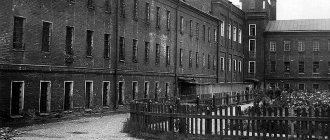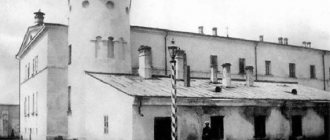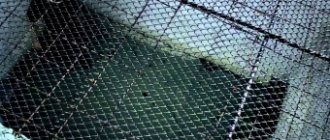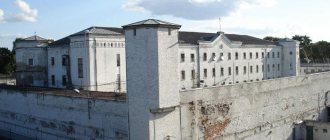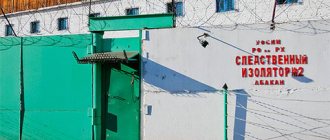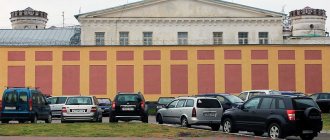Butyrka Prison (currently Pre-trial Detention Center No. 2 of the Federal Penitentiary Service) was founded in 1771 by order of Catherine II. The provincial prison castle was designed by the architect Kazakov. According to the original plan, the structure was supposed to be a hexagonal elongated ensemble. It was planned to build 4 round crenellated towers in the corners, connected by high brick walls. Well, this project was brought to life. There are 4 towers in Butyrsky Castle: Clock, Pugachevskaya, Police and Northern. In the center of the buildings there was a church. And today, prisoners can visit the temple in Butyrka prison without hindrance.
Instruments of torture
In those days, the Butyrka prison was characterized by extremely cruel conditions. In the royal prison there were many weapons for burdening prisoners: stocks, slingshots, handcuffs, chairs, clamps... Prisoners could be chained even for a minor offense. The slingshot was a special metal collar that did not allow the prisoner to lie down. There were three types of chains used in prison; they were placed on the arms, legs and neck. Sometimes criminals were additionally chained to the wall. Chairs were used to prevent escapes. They were made from an oak block weighing up to 25 kg and bound with steel hoops. A collar was attached to the prisoner's neck. The prisoner had to go like this even to the bathhouse and toilet.
Butyrka prison. Part 1
Butyrka prison, Butyrka, pre-trial detention center 2 is the largest prison in Moscow, the history of which goes back several centuries. Over the years, many different people have been in its dungeons - both respected and notorious scoundrels...
“I walk back and forth, wipe my soles, inhale the oxygen of the prison yard. The rough wall reliably guards, the seal is smeared, Butyrka prison.
Butyrka prison, fate breaks down. Butyrka prison, my soul is so tormented. Butyrka prison, life does not end. The prison stands, the capital sleeps, the Earth rotates”... (song by the group “Butyrka”)
We can talk for a long time about this institution, which has all-Russian fame: the Butyrka building is a protected architectural monument with many interesting things, including, they say, a mysterious underground passage; famous, respected people and equally well-known criminals who in one year or another became prisoners of this prison; successful and failed escapes of some of them; Butyrka Temple, its museum and many other fascinating facts...
Now Butyrskaya prison is located almost in the very center of Moscow, which, of course, is not liked by residents of nearby houses. But in the 17th century, when the history of Butyrka began, there was the village of Butyrkino, from which, in fact, the correctional institution built here received its name.
Butyrka 19th century
In the village of Butyrkino there were barracks of a cavalry regiment, which, by order of Catherine II, began to be converted into a prison castle, consisting of four towers connected by very thick walls. And in the center of this building the Intercession Church was erected. The building project was developed by architect M.F. Kazakov.
In the 19th century and at the beginning of the 20th century, the Butyrka prison was repeatedly rebuilt and expanded, in particular, another floor was added to the building.
Pugachev Tower, Butyrka
The four towers of the Butyrka prison have survived to this day, and originally had the following names: South, Hour, North and Police. But the South Tower was soon renamed Pugachevskaya, since it was in this tower that the Don Cossack Emelyan Pugachev was kept in chains and sent to execution in January 1775.
Some experts claim that already in those days there was a wide underground passage under the Butyrka building that connected the prison with the Kremlin. Allegedly, it was for this reason that Catherine II came in a carriage to gawk at Pugachev.
It seems to me that if the underground passage actually exists, those who are supposed to know about it probably know about it. After all, undoubtedly, both the prison building and everything that is under it have been studied to the smallest detail. Perhaps the underground passage was previously passable, and later it was walled up. It is unlikely that anyone would want the Kremlin to be connected to an institution that could house up to three thousand prisoners.
However, according to the story of one of the employees of the Butyrskaya prison, the underground passage existed at least in 1993, although it did not lead to the Kremlin, but to the Novoslobodskaya metro station. It was through this underground passage that the escape was made that year. Moreover, according to some experts, there are several underground passages under Butyrka.
In the 19th century, Butyrka Prison also became a transit prison, from which prisoners were sent into exile in Siberia. For example, in the spring of 1882, nine women were waiting in the Pugachev Tower to be sent to Siberia, and 23 men were waiting in the other three towers.
On the territory of Butyrka there was also a shelter for families who wished to follow the exiles.
At that time, there were several workshops in the prison: bookbinding, carpentry, shoemaking, tailoring, and even workshops for the production of Viennese chairs, which were fashionable in those years, and wood burning. The criminal business also flourished - in 1873, in particular, a gang of counterfeiters was uncovered in Butyrka.
Cell in Butyrka prison a century ago
Conditions in the prison at that time were terrible: instead of mattresses, there was straw on the bunks; there was no bed linen, water or sewerage.
Interesting fact. Leo Tolstoy came to this prison in 1884, visiting a friend. And a few years later, the writer, while working on the novel “Sunday,” not only asked a warden he knew in detail about the life of prisoners, but also walked with those sent into exile from the Butyrka prison to the station.
Harry Houdini. Escape from Butyrka
In 1908, Butyrka prison became the place where Harry Houdini, an American actor and illusionist, demonstrated his abilities.
Butyrka employees and police claimed that it was impossible to escape from this prison, but Houdini said that he would do it easily. The illusionist was examined, stripped and locked in solitary confinement. Newsmen gathered in front of the prison, to whom Butyrka's management was giving a lecture about the impossibility of escaping from prison, when the locked door opened and Houdini appeared from behind it...
V. Mayakovsky in Butyrka prison
In 1909, in Butyrka prison, in solitary confinement No. 103, Vladimir Mayakovsky was sitting, who also wrote his poems here. True, the poet was dissatisfied with what came from his pen: “An entire notebook was filled with poems. Thank you that the guards took her. Otherwise I would have published it. I'm talking about tearful poems like these: The forests dressed in gold and purple, the sun played on the domes of churches. I waited: but the days were lost in the months, hundreds of tedious days...”
Beginning in 1911, the anarchist N. Makhno served his sentence in Butyrka for six years. He was illiterate, but the anarchist and terrorist P. Arshinov, who was sitting in the same cell with Makhno, taught him mathematics, history and literature. Makhno was a troubled prisoner - he actively participated in prison protests and was imprisoned in a punishment cell 6 times.
And in 1916 - 1917 Butyrskaya prison became home to F. Dzerzhinsky.
There were a particularly large number of prisoners, many of whom were never released, in Butyrka prison during the years of mass repressions of 1937-1938. The prison, designed at that time for a maximum of 2,500 people, could house up to 20,000 prisoners at a time. You can imagine the conditions under which they existed! Each cell housed 170 people who took turns sleeping and eating.
In the thirties and forties of the last century, in Butyrka prison, in particular, there were:
Osip Mandelstam - poet and translator, accused of anti-Soviet agitation;
Sergei Korolev is a designer of the rocket and space industry, accused of carrying out work to disrupt the development of new types of weapons;
Dmitry Artsybashev - engineer, accused of sabotage and recognized as an enemy of the people (died in Butyrka);
A. Solzhenitsyn
Alexander Solzhenitsyn is a writer, poet and politician who ended up in Butyrka after a conflict with the management of a design bureau.
“Do you remember - the air, stagnant, as if in a pit, the gray vaults of the old good prison, where on the dark long July days we grieved about great and small things?” (A. Solzhenitsyn, “Memories of Butyrka Prison”).
At the beginning of 1942, Hitler’s nephew, Heinz Hitler, who was captured, was held in Butyrka for almost two months (until his death).
During the Second World War, Butyrka prison opened workshops on its territory in which prisoners worked for the needs of the army.
Butyrka prison from the inside
Now Butyrskaya prison includes almost two dozen three-story buildings. In total there are 434 cells and 32 punishment cells. It has a gym and sports halls.
Interesting fact. It was no longer possible to expand the territory of the prison, and the need for space was great, so in the nineties of the last century, an apartment building located near the institution was resettled (lucky residents!), and the building came under Butyrka’s department.
What do prisoners do in Butyrka? I mean work, because they are obliged to work and receive a salary, albeit a small one. Prisoners can save money until they are released, or they can pay in the prison store. However, in this case, payment is made not in cash, but in special receipts.
So, when a person ends up in Butyrka prison, he has to go through a special commission that will determine his inclinations and decide what kind of work the prisoner will do.
Interesting Facts:
Crime boss Sergei Lipchansky
In 1994, criminal authorities, led by Sergei Lipchansky (nicknamed “Sibiryak”), who had recently been released from Butyrka prison, decided to see their comrades who were still imprisoned. They agreed with the prison staff, and they organized a meeting. But this became known to law enforcement agencies, who detained both the “authorities” and the employees who helped them. Two prison employees received real prison sentences, the rest were fired.
In 2000, Vladimir Gusinsky, a media magnate, owner of NEWSru.com, who, together with his “comrades,” was accused of stealing property from the state worth ten million dollars, spent three days in Butyrka prison. Three days later he was released on his own recognizance.
And in Butyrka, one of the most famous criminals of the USSR, Sergei Golovkin, nicknamed “Fischer,” was imprisoned and executed.
To be continued…
Famous personalities of Butyrka
Within the walls of this Moscow prison in the 19th and early 20th centuries. Many famous personalities visited: Bauman, Schmidt, Voroshilov, Dzerzhinsky, Makhno, as well as many participants in the 1905 uprising. Since 1906, Butyrka prison began to be called the Temporary Central. An extremely harsh regime was introduced there; flogging was even introduced as punishment. The “fruits” of the new regime were not long in coming: epidemics of various diseases began, and a wave of suicides swept through. In 1910-1911 Up to 400 prisoners died per day (mainly due to consumption). Under the chief Kudryakov (in 1908), the former royal prisoner turned into hell: flogging became commonplace, and those who were especially disobedient were sent to punishment cells.
Historical figures
Historical documents indicate that in 1874, Russian revolutionary Yegor Lazarev was transferred from Samara to Butyrka prison, arrested for participation in the student movement “Walking to the People” and revolutionary activities in the “People’s Will” organization.
At one time, he knew the writer Leo Tolstoy, who by this time was planning to write a novel about social injustice in Russia. To this end, in 1884 he visited his close acquaintance, the prisoner Lazarev, and 15 years later he came to the capital’s prison to, together with convicts sentenced to various terms of hard labor, walk the path from Butyrskaya prison to Nikolaevsky station (now the station is called “Leningradsky” ). As a result, this path was reflected in the novel “Sunday”, and Yegor Lazarev became a real person to create the literary hero of the revolutionary Nabatov.
During the armed uprising that took place in Moscow in 1905, the workers of the tram depot tried to free the political prisoners of the Butyrka prison, but the attack on the prison building ended in failure: they were repulsed by the convoy team and disarmed. Many were arrested and placed in prison dungeons.
Interesting fact: in 1908, in the Butyrka prison, the then famous American philanthropist and magician Harry Houdini performed for the prisoners. The artist, shackled and placed in a transport box built to transport prisoners from Moscow to the place of hard labor, managed to free himself in 28 minutes, overcoming all difficulties.
According to surviving prison documents, historians have established that in the period 1905-1910, many historical figures of Russia were kept in the capital's prison. Among them was Ivan Kalyaev, a Russian terrorist and organizer of the murder of Grand Duke Sergei Alexandrovich Romanov (fifth son of Alexander II).
Nikolai Shmit, a participant in the revolutionary actions of 1905, died before his trial in the Butyrka prison casemates in 1907. It is noteworthy that in his will he donated his entire fortune to the fight against the existing tsarist regime. In 1909, the poet Vladimir Mayakovsky was arrested and placed in Butyrka for revolutionary activities. He spent 11 months in the dungeons.
The Ukrainian political figure Nestor Makhno was brought from Odessa to the convict department of the Butyrka prison in 1911, after being sentenced to indefinite hard labor for the murder of an employee of the military commandant’s office. After the revolutionary events of 1917, he was released and continued to engage in political activities. Together with Makhno, the future chairman of the Cheka, Felix Dzerzhinsky, was released from prison.
Relaxation of the regime
After the revolution of the 17th year, chains, shackles and other weapons were abolished. They were also allowed to go to windows, see relatives and receive parcels. The Butyrka Church was liquidated, and a blacksmith shop and a hardware workshop were set up in its building. They organized a library and allowed to organize concerts. In 1920, F. Chaliapin performed here.
Since 1983, female prisoners have been transferred to a separate building. In 1996, all criminals who were in other pre-trial detention centers were sent here. It is also worth noting that numerous re-equipment and reconstruction were carried out independently, without receiving any technical documentation. Therefore, many buildings do not meet current building codes and regulations.
The fate of Butyrka after 2000
In 2001, renovation work was carried out throughout Butyrka. The regime buildings were completely renovated. The Church of the Blessed Virgin Mary has been restored and is still in operation today. Since 2003, the Department of Narcology and Psychiatry has been functioning in pre-trial detention center No. 2 for advanced training and retraining of medical personnel.
Many people are interested in: where is Butyrka prison located? Address of pre-trial detention center No. 2 of the Federal Penitentiary Service: Moscow, st. Novoslobodskaya, 45 (this is 4 km from the center of the capital). Now the institution is protected by the state as a unique architectural monument.
Will Butyrka become a museum?
Butyrka may soon turn from a prison into a museum. State Duma deputies have already considered the demand to close the detention center several times, but so far no results have been achieved.
Residents of the surrounding houses constantly asked to consider closing the prison. Firstly, the view from their windows is depressing - the windows are barred. Secondly, there is a strong smell of officialdom in the yard. And thirdly, there is always a queue along the entrances to the information desk of the pre-trial detention center. In addition, there is one more important point. In the area where the Butyrskaya prison is located, it is impossible to sell an apartment at the market price, which is understandable.
After complaints from Muscovites, many deputies proposed moving prisoners to the pre-trial detention center on Vilyuiskaya Street, where, by the way, the living conditions are much better. And in Butyrka you can simply open a prison museum. However, this issue has not yet been resolved. Some officials believe there is a risk of criminals escaping during transport. And there are also more “exotic” proposals - to move the mausoleum to Butyrka.
Butyrka's first prisoner
According to historical documents, the first prisoner of the Butyrka prison in Moscow was the leader of the Peasant Uprising, Don Cossack Emelyan Pugachev. At the end of 1774 the revolt was suppressed. Then Pugachev was arrested. Afterwards he was taken to Moscow and placed in one of the towers of the Butyrka prison.
Before the execution of the death sentence, the prisoner was kept in a cage under heavy security. Now this tower is called “Pugachevskaya”, and the cage is located in the Moscow Historical Museum.
Significant events
The Butyrka prison saw within its walls famous writers, political figures, scientists, etc. The most significant event of recent times was Gusinsky’s short imprisonment. He had the most criminal place here - a bed by the window on the first tier; they even installed a TV in his cell.
However, now you can see a TV in every cell. Butyrka also has a library with a good selection of thrillers, classics and science fiction.
In their free time, prisoners engage in a wide variety of activities. They make instruments for tattooing, make knives from cans and mugs, some even manage to construct a homemade pistol. The usual entertainments of the “prisoners” are dominoes, backgammon, and chess. It is prohibited to play cards in prison. Today, of course, you won’t be shot for this, but you can be put in a punishment cell. There are no problems with food. Although just a couple of years ago everything was much worse. By the way, since 1996, women are no longer placed here.
Prison during the years of political repression
During the period of mass political persecution (1937-1939), prose writer and poet Varlam Shalamov, accused in 1937 of denunciation of counter-revolutionary activities, was kept in prison.
In 1939, the future General Designer of spaceships Sergei Korolev was sent to the cells of the Butyrka prison as the organizer of sabotage at the Jet Institute. Five years later he was released with his conviction expunged.
In 1934, the writer and poet Osip Mandelstam, accused of anti-Soviet activities, which, according to investigators, sounded in his literary works, was held for some time in Butyrka prison before being sent to Vorkuta.
Prison documents from that period list the prisoner Boris Fomin, a composer of Russian romance, who was sent to the capital's prison for one year on false charges.
During the Great Patriotic War, all prison inmates worked in closed equipped workshops for the needs of the front.
Sensational escapes
Whatever happened in pre-trial detention center No. 2, Moscow is still full of some rumors. Butyrka prison has seen many talented escapees over its long history. There are still legends about Lieutenant Lantsov, who was constantly engaged in hooliganism. He was put in Butyrka more than once, but each time he managed to get out of there. They also say that one of the prisoners escaped straight from the investigator’s office. And he hid until World War II.
They also tried to escape in post-Soviet times. In 1992, two inmates tore out the metal mesh in the exercise yard, climbed onto the roof, jumped from the height of the third floor and disappeared. True, they were detained a few days later.
In 1996, a girl decided to escape. She pretended to be a prisoner who really should have been released, and calmly left the pre-trial detention center. She was detained 3 days later.
In 2000, a Georgian citizen managed to escape. However, he was caught after 5 days. In the same year, three especially dangerous criminals escaped from death row, having dug into the cement floor with spoons in a couple of days. Two of them were found after 3 weeks, and the third was caught only in April 2003.
But the most spectacular escape from Butyrka prison was made by 26-year-old prisoner Vitaly Ostrovsky (Belarusian). It happened on April 22, 2010. He jumped over the high fence of the pre-trial detention center while being escorted. It has not been possible to find him to this day. Inspired by Ostrovsky’s escape, two days after his “feat,” 24-year-old Vitaly Loktev, convicted of child abuse, escaped. The man squeezed out the window bars and jumped from the roof of the detention center. But this attempt, fortunately, was a failure - he was found the same day.
History of Butyrka prison. Photo
During her reign, Catherine II, by her decree, ordered the construction of a barracks building for the hussar regiment with a prison on the territory of the Butyrsky farm.
At the request of the Russian Field Marshal Zakhar Chernyshev, who at that time was the Governor General of Moscow, the Empress in 1771 gave written consent to the construction of a stone prison on the site of a dismantled wooden stronghold, which served as temporary detention for prisoners.
Attached to the letter was a design of the proposed building. It was designed by Russian architect Matvey Kozakov. The designed prison ensemble, taken as a basis, consisted of a main building, around which there were four towers connected to each other by a stone wall.
By 1792, the construction of the prison complex was completely completed. After 76 years, the prison castle officially began to bear the name “Central Transfer Prison.”
At that time, workshops operated on the territory of the prison, where prisoners worked to produce various household items. Products made from steam-bent beech wood (Viennese furniture) were in particular demand.
The prison leadership created the Sergiev-Elisavetinsky charitable institution for wives who voluntarily agreed to follow their exiled relatives and husbands to Siberia. Interesting fact: in 1873, a group of prisoners was discovered manufacturing counterfeit coins of tsarist mintage in metalwork shops.
From 1877 and over the course of two years, the prison complex was rebuilt according to the design of the Russian architect Alexander Shimanovsky. New extensions to the main building were erected. Since 1881, the capital's prison served as a transit point for political prisoners before being sent to Siberian penal servitude.
Butyrka Museum
There has been a museum here since 1971, but getting into it is not so easy. Visiting it is allowed only upon application from a legal entity. But if this succeeds, then the excursion to Butyrka prison will be remembered for a long time. In the museum, for example, you can see many amazing exhibits taken from the stomachs of prisoners: scissors, bolts, spoons. And one of the prisoners even swallowed 28 pieces of dominoes at once. They had to be removed surgically. The various homemade tools are also impressive: knives, pistols, tattoo machines.
"Butyrka" in art
— According to the plot of the comedy “Mimino”, the main character Valiko Mizandari ends up in cell 8 of “Butyrka”. He personally informs about this upon admission to pilot courses.
— In 2001, the Butyrka group was founded. The musicians gave this name to the group after the prisoners attempted to escape in 2001. There is another group that sang a song about pre-trial detention center No. 2 - “Ace of the Cross”. Butyrka prison, thanks to their compositions, became even more famous, and far beyond the borders of Russia.
— The prison scenes of the TV series “Seventeen Moments of Spring” were filmed here. They say that when artists in SS and Gestapo uniforms walked along the prison corridors, some prisoners from among the servants jokingly exclaimed: “Oh, our people have come!”
— Hollywood actor Mickey Rourke also visited Butyrka to get into character in the film Iron Man 2.
So, it's time to take stock. Butyrskaya Prison is considered one of the most famous prisons in Russia, the address of which, by the way, may change in the near future. True, so far, despite the fact that the detention center has not met many requirements and sanitary standards for a long time, there is no hurry to relocate prisoners. But even if this happens, the building of pre-trial detention center No. 2 will terrify people for many years to come.
